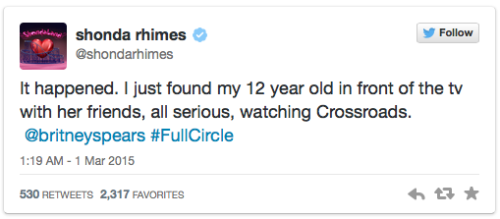This is a guest post by Scarlett Harris.
Grey’s Anatomy and Scandal showrunner and How to Get Away with Murder executive producer Shonda Rhimes recently tweeted the following:
In the haze of her Shondaland television production empire, many people forget—or aren’t aware at all—that Rhimes’ success began in 2002 when she wrote the screenplay for a little movie called Crossroads, which also happened to be Britney Spears’ silver screen debut. Spawning the coming of age anthems “Not a Girl, Not Yet a Woman” and “Overprotected,” Crossroads may have been a critical flop but it drew $61 million internationally and will forever remain a cult classic for many millennials, myself included.
Another of Rhimes’ success stories that allowed her to go on to produce some of the hottest dramas on TV was Grey’s Anatomy. Originally sweeping the Golden Globe and Emmy nominations (with a few wins here and there) in its early years, the general consensus about Grey’s today is consternation that it’s still airing after 11 seasons. What originally began as a dramatic look at the lives of a diverse cast of surgical interns arguably devolved into a shark jump of epic proportions with Izzie’s cancer-induced hallucinations and a musical episode. As a lifelong Grey’s fan, I’ll defend it to the death and contend that it has corrected course in the past few years while not being afraid to take risks.
At first glance, two of Rhimes’ early successes might not look so similar, but I’m here to argue that Crossroads acted as a dry run for Grey’s Anatomy. Let me count the ways…
First, both center on a somewhat boring white woman whose less conventional friends turn out to be much more interesting. Crossroads (along with Center Stage) introduced us to Zoe Saldana, the well-to-do popular girl to Spears’ awkward valedictorian and Taryn Manning’s pregnant teen from the wrong side of the tracks, subverting stereotypes of race in the small Georgian town where the movie is set, which has become Rhimes’ calling card.
In Grey’s, Meredith finds immediate kinship with Cristina Yang, and later brings Latina Callie Torres and mixed race half-sister Maggie Pierce into a fold that’s more fucked up than their Crossroads counterparts. Like Orange is the New Black (in which Manning also stars), Meredith and Lucy act as Trojan horses to introduce audiences to the lives of other, more diverse women.
There’s also the awkward, bumbling love-interest-that-wasn’t. In one of Crossroads’ opening scenes, we see a lingerie-clad Lucy about to have sex for the first time with Justin Long’s Henry, who’s pined after Lucy for the three years they’ve been lab partners. Over in Shondaland, it was Meredith who drunkenly succumbed to George’s subtle advances, but it was not to be–she started crying during sex and damaged their friendship, working relationship, and housemate dynamic for a long time. (The one aspect in which Grey’s differs to Crossroads is that Anson Mount’s Ben is certainly no McDreamy.)
Crossroads is a road trip flick whereas Grey’s primarily takes place inside a hospital, but make no mistake: there have been plenty of outings away from the four walls of Seattle Grace/Mercy West/Grey-Sloane Memorial Hospital. These include the men’s camping trip in which Alex and George get into a “slap-fight” (“open-handed combat” to protect their surgeon hands); the residents’ sojourn to San Francisco to take their boards where April and Jackson finally get it on; Cristina’s fellowship at the Mayo Clinic sees her isolated in icy Minnesota; and the car accident involving Callie and Arizona which spawns the abovementioned musical episode, “Song Beneath the Song.”
Speaking of music, Crossroads is a film that utilizes it quite heavily and with Britney Spears as your leading lady, you’d be (“Drive Me) Crazy” not to. In addition to the songs I mentioned above, there’s also the requisite karaoke scene in which Spears, Manning and Saldana sing “I Love Rock & Roll,” also released as a single for Spears. Like The O.C. before it, Grey’s is one of those TV shows that has become better known perhaps for its music than its melodrama. In 2006, the show won a Grammy for best compilation album featuring two of the songs the show is perhaps best known for: “Chasing Cars” by Snow Patrol and “How to Save a Life” by The Fray. Both have the requisite Madonna singalong while Grey’s has made famous the “five second dance party” and drunken boogie sessions Meredith and Cristina frequently engage in.
Finally, both protagonists have strained family lives. Lucy in Crossroads grew up with her father (Dan Aykroyd) after her mother left them to start a new family; this is part of the reason Lucy tags along on the road trip in the first place. The titular Meredith Grey rivals Lucy in the dysfunctional family department: in addition to her father walking out and her mother’s cold and distant demeanour, Meredith discovers later in life that she has not one but three half-sisters spawned from her parents’ subsequent dalliances (spoiler alert: these sisters three don’t all share the same DNA).
Crossroads’ Mimi (Manning) begins the movie pregnant but miscarries at the culmination of the road trip, while Grey’s Izzie gave the product of her teen pregnancy up for adoption. Where Crossroads doesn’t deal with abortion, Grey’s certainly does, with Cristina undergoing an abortion and a miscarriage for her two pregnancies. For a teen movie, Crossroads isn’t afraid to deal with rape, either, which is how Mimi came to be pregnant in the first place.
At first glance the two Rhimes productions couldn’t be more different, and while Grey’s is far more sophisticated, Crossroads is evidence that Rhimes began her progressive storytelling long before Meredith, Olivia, Annalise and co. hit our TV screens. Who would have thought that Britney Spears would be involved?
Scarlett Harris is a Melbourne, Australia-based freelance writer and blogger at The Scarlett Woman, where she writes about femin- and other -isms. You can follow her on Twitter.













Great article <3